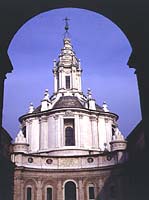St. Ivo alla Sapienza
 Our favorite Baroque Church: The finest masterpiece by the finest master of Rome's Baroque architecture.
Our favorite Baroque Church: The finest masterpiece by the finest master of Rome's Baroque architecture.
Francesco Castello (1599-1667), who assumed the name Borromini and considered himself the spiritual heir of Michelangelo, built this church inside the existing courtyard of the University of Rome.
Top British architect Lord (Richard) Rogers says St. Ivo's "Blows my mind."
Borromini enlivened the University courtyard's extremity by surmounting it with a giant drum above which a spiral ice-cream cone seems to have been upended. A Middle Eastern ziggurat is the only architectural precedent for this twisted lantern-top.
Even in a holy building, Borromini was as playful as he was in designing the fool-the-eye false perspective in nearby Palazzo Spada. His use of angels as architectural features on the outside is quite simply marvelous.
The interior is even more unexpected. You enter a dazzling white space, rounded and narrow at the bottom, but soaring up to a well-lit and gilded dome.
Movement, a central characteristic of the Baroque, is dramatic: the walls are fluted, covered with niches of alternating shapes and dimensions; concave and convexes are everywhere.
Outsized Corinthian pilasters carry your eye up to the dome's base, which echoes the rounded hexagon of the floor plan, except that the limbs of the upper hexagon are alternately curved and rectangular.
The ribs of this tent-like dome are accentuated with eight-pointed stars that look like starfish swimming up toward the lantern. And the lantern at the very top seems to be disappearing into heaven.
| St. Ivo alla Sapienza History 1303. Pope Boniface VIII (who invented Jubilees) founded Rome's university. 1575-87.Giacomo della Porta completed the university building with its large courtyard, the Palazzo della Sapienza.. 1642-48. Borromini's design for the Church was carried out, but the interior decoration took another couple of decades and was completed after his death. |
Palazzo della Sapienza
(1575 Giacomo della Porta). Is square and massive, and its inner cloister gives a sense of overwhelming heaviness.
But the little jewel that Borromini designed behind the round wall at the far end of the cloister is a soaring leap of artistic, as well as spiritual, faith.
Open for mass Sunday 10 – 12 am. Closed July and August